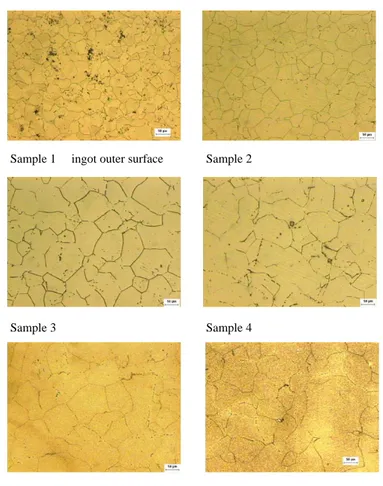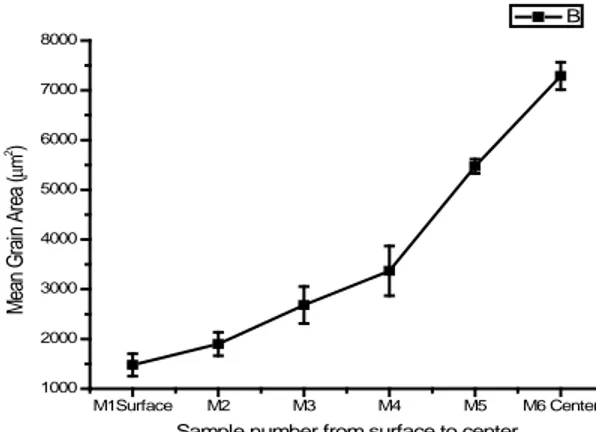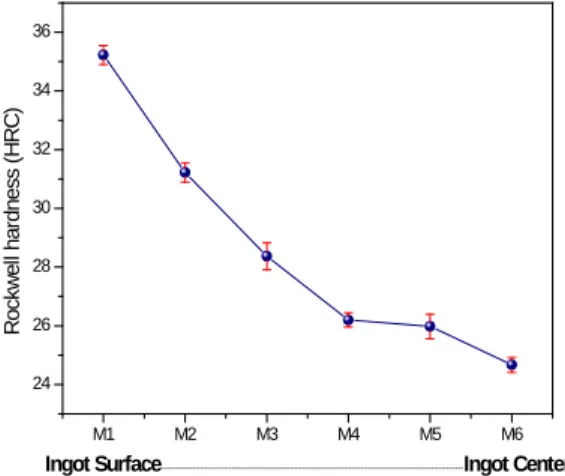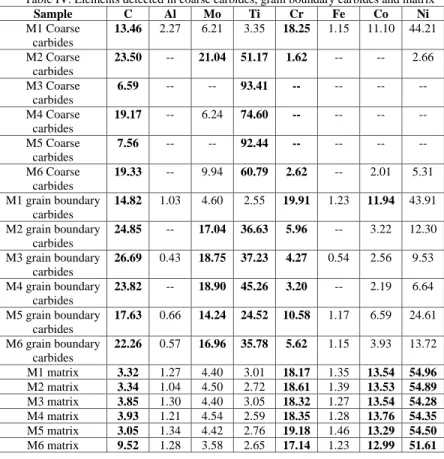METALLURGICAL CHARACTERIZATION OF WASPALOY PRESENTING VARIATIONS IN CHEMICAL COMPOSITION, GRAIN SIZE AND HARDNESS
Texto completo
(2) To obtain optimum properties, γ´-strengthened superalloys must be homogenized following casting (or prior to hot working in ingot-metallurgy approaches) at temperatures between the γ´solvus and the solidus. At these temperatures, the γ´-phase dissolves relatively quickly in the γ matrix, but substantial time (usually many hours) is required to obtain a uniform distribution of alloying elements via diffusion processes. The objective of the present work is the metallurgical characterization of Waspaloy including its chemical analysis, and its characterization by optical microscopy, scanning electron microscopy and EDX analysis, in order to determine if the as cast ingot shows a heterogeneous microstructure and variations in chemical composition (segregation), grain size and hardness, from the external surface to the center of the Waspaloy ingot.. Figure 1. Waspaloy forged rings. Experimental Procedures Metallurgical characterization of the samples consisted of: chemical composition determination by ICP analysis, microstructure determination by optical and scanning electron microscopy and EDX, mean grain size measurement by image analysis, and Rockwell C hardness measurements. The material used in the present work was a 304.8 mm diameter hot-rolled bar of Waspaloy. It had a measured chemical composition showed in Table I. Table I. Chemical composition of the Waspaloy ingot.. Nominal Measured. C 0.03-0.10 0.036. Mn 0.0-0.10 0.02. Si 0.0-0.15 0.03. S 0.0-0.015 0.003. P 0.0-0.015 0.004. Nominal Measured. Co 12-15 13.24. Fe 0-2.0 0.9. Mo 3.5-5.0 4.19. Ti 2.75-3.25 3.06. Al 1.2-1.6 1.36. 642. Cr 18-21 19.61. Ni Bal. Bal.. B Zr .003-0.010 0.02-0.08 0.007 0.06.
(3) The microstructure of the as-received bar was examined in six representative locations, one at the outer diameter, 4 in the mid-radius, and one at the center. Figure 2 shows the sites where the samples were obtained from the Waspaloy ingot. The samples were prepared for the purpose of obtaining optical micrographs to show the grain size, grain morphology, grain distribution, and second phases of the matrix. Figure 3 shows the micrographs obtained from the six samples, from the external diameter to the center. The grain size was measured by optical microscopy and image analysis, in accordance with ASTM Standard E-112. Table II and Figure 4 show the obtained results of grain size for samples M1 to M6. Rockwell “C” hardness was measured on the external surface of the 6 samples. Table III and Figure 5 shows the hardness profile obtained from the outer surface (M1), to the center of the ingot (M6).. Figure 2. Location of the six samples obtained from the Waspaloy ingot.. Table II. Average grain area and ASTM grain size values of samples Sample # M1 M2 M3 M4 M5 M6. 1 1030.97 1642.5 2862 3302.5 5323.6 7000. 2 1647.51 1681.36 2084.38 3354.12 5757.84 7024.8. 3 1754.76 2373.29 3097.69 3456.6 5326.56 7839.93. 643. Average grain area (µm2) 1477.74667 1899.05 2681.35 3371.07333 5469.33333 7288.24333. ASTM Grain size 6.5 65.-6.0 6.0-5.5 5.5-5.0 5.0-4.5 4.5-4.0.
(4) Sample 1. ingot outer surface. Sample 3. Sample 2. Sample 4. Sample 5. Sample 6 ingot center. Figure 3. Microstructures of the ingot, from the outer surface (Sample-1) to the ingot center (Sample-6).. 644.
(5) B 8000. Mean Grain Area (µm2). 7000 6000 5000 4000 3000 2000 1000 M1Surface. M2. M3. M4. M5. M6 Center. Sample number from surface to center. Figure 4. Average grain area and ASTM mean grain size.. Table III. Average Rockwell C hardness on the Waspaloy ingot samples Sample M1 M2 M3 M4 M5 M6 Rockwell “C” 37 30.7 30 27.5 28 23 hardness 36 32 29.8 26.5 26.2 24.5 36 31.8 29 26.5 25 25 35 32 29.4 25.5 25.8 25 35 32 28.8 27.0 25.0 24 35 31.5 28 25.3 25.0 25 35 31 27 26 26.0 25 34 31 27.3 25.5 24.8 25.5 34 29 26 26 28.0 25 Mean value 35.22 31.22 28.36 26.2 25.97 24.66. 645.
(6) 36. Rockwell hardness (HRC). 34 32 30 28 26 24 M1. M2. M3. M4. M5. M6. Ingot Surface-------------------------------------------------------------------------------------------------------Ingot Center. Figure 5. Average Rockwell C hardness measured on the Waspaloy ingot samples.. The microstructure was determined by scanning electron microscopy and EDX, identifying the phases that were present in the matrix, such as blocky carbides located inside the grains, and tiny carbides located on the grain boundaries. Figure 6 shows the microstructures of the six samples, from the outer surface to the center of the ingot. EDX analyses were performed in order to identify the carbides that are present in the microstructure of Waspaloy ingot. Grain boundary carbides contain carbon, molybdenum, titanium and chromium. Coarse carbides contain carbon, titanium and molybdenum, as shown in Table IV.. 646.
(7) 3μm. 6μm. Sample M1. Sample M2. 7μm. 7μm. Sample M3. Sample M4. 7μm. 7μm. Sample M5. Sample M6. Figure 6. Scanning electron micrographs of the six samples obtained from the Waspaloy ingot, from outer surface (M1) to the ingot center (M6), showing coarse carbides of Mo and Ti, and carbides located on the grain boundaries.. 647.
(8) Table IV. Elements detected in coarse carbides, grain boundary carbides and matrix Sample C Al Mo Ti Cr Fe Co Ni M1 Coarse 6.21 3.35 18.25 1.15 11.10 44.21 13.46 2.27 carbides M2 Coarse ---2.66 23.50 21.04 51.17 1.62 carbides M3 Coarse -----6.59 93.41 -carbides M4 Coarse -6.24 74.60 ---19.17 -carbides M5 Coarse -----7.56 92.44 -carbides M6 Coarse -9.94 60.79 2.62 -2.01 5.31 19.33 carbides M1 grain boundary 14.82 1.03 4.60 2.55 19.91 1.23 11.94 43.91 carbides M2 grain boundary 24.85 --3.22 12.30 17.04 36.63 5.96 carbides M3 grain boundary 26.69 0.43 18.75 37.23 4.27 0.54 2.56 9.53 carbides M4 grain boundary 23.82 --2.19 6.64 18.90 45.26 3.20 carbides M5 grain boundary 17.63 0.66 14.24 24.52 10.58 1.17 6.59 24.61 carbides M6 grain boundary 22.26 0.57 16.96 35.78 5.62 1.15 3.93 13.72 carbides M1 matrix 1.27 4.40 3.01 18.17 1.35 13.54 54.96 3.32 M2 matrix 1.04 4.50 2.72 18.61 1.39 13.53 54.89 3.34 M3 matrix 1.30 4.40 3.05 18.32 1.27 13.54 54.28 3.85 M4 matrix 1.21 4.54 2.59 18.35 1.28 13.76 54.35 3.93 M5 matrix 1.34 4.42 2.76 19.18 1.46 13.29 54.50 3.05 M6 matrix 1.28 3.58 2.65 17.14 1.23 12.99 51.61 9.52. Results and Discussion Chemical Composition The chemical composition of the Waspaloy ingot meets the ranges specified in nominal composition, and it is within the range specified in Table I. There are no significant variations in the chemical composition among the six analyzed samples, as shown in Table IV.. 648.
(9) Microstructure The grain size on the external surface of the Waspaloy ingot is smaller than the grain size at the center of the ingot, as shown in Table II and Figures 3 and 4. This variation in grain size is due to different cooling rates on the external surface and the center of the Waspaloy ingot. The center of the ingot has a lower cooling rate than that of the external surface. The microstructure of Waspaloy constitutes of a nickel matrix (γ), a γ′ phase as fine precipitates, and a minor amount of carbide grains which occur at the grain boundaries and in the nickel matrix [2]. Figure 6 shows the different carbide grains located on the grain boundaries and inside the nickel matrix; these carbide grains were analyzed by scanning electron microscopy and EDX to determine their compositions. Table 4 shows the detected elements in each type of carbide; the blocky carbides are composed principally of titanium (92-93 wt.%) and in some cases molybdenum (6-21 wt.%), titanium (51-74 wt.%) and chromium (1-18 wt.%). Carbides located at the grain boundaries contain titanium (24-45 wt.%), molybdenum (4-18 wt.%) and chromium (3-19 wt.%). Hardness The Rockwell “C” hardness of the sample located on the external surface (35 HRC) of the ingot is higher than the hardness of sample located at the center (24 HRC), as shown in Table III and Figure 5. Variations of microstructure, such as grain size and the phases present, may cause a non-uniform strain distribution on forged rings, causing cracks in zones of different grain size, specially when the geometry of the ring is complicated with zones of different thicknesses. Conclusions • • •. There is no significant variation in the chemical composition among the six samples of Waspaloy ingot analyzed. The microstructure shows variations in grain size from the external surface to the center of the ingot; the mean grain size on the external surface is smaller than that of the ingot center. The grain size distribution is not homogeneous within the same sample analyzed. Rockwell “C” hardness is lower in the center of the ingot than that of the external surface.. Acknowledgments This work was conducted as part of the project # 20162, entitled: “Development of new high temperature resistant components for aircraft engines of reaction with superalloys”, carried out by CIMAV, S.C. and FRISA Aerospace, supported by CONACYT.. 649.
(10) References [1] M.J. Donachie Jr., editor. Superalloys Source Book, ASM International, (1984). [2] S.L. Semiatin, R.C. Kramb, R.E. Turner, F. Zhang and M.M. Anthony, “Analysis of the homogenization of a nickel-base superalloy”, Scripta Materiala, 51, (2004), 491-495. [3] R.C. Kramb, M.M. Antony, and S.L. Semiatin, “Homogenization of a nickel-base superalloy ingot material”, Scripta Materiala, 54, (2006), 1645-1649. [4] W.H. Couts, Jr. and T.E. Howson: in Superalloys II, C.T. Sims, N.S. Stoloff and W.C. Hagel, eds., Wiley, New York, NY, (1987), 441-58. [5] G. Shen, S.L. Semiatin, and R. Shivpuri, “Modeling microstructural development during the forging of Waspaloy”, Metallurgical and Materials Transactions A, 26A, (1995), 1795-1803. [6] S. L. Semiatin, D.S. Weaver, P.N. Fagin, M.G. Glavicic, R.L. Goetz, N.D. Frey, R.C. Kramb and M.M. Antony, “Deformation and recrystalization behavior during hot working of a coarsegrain, nickel-base superalloy ingot material”, Metallurgical and Materials Transactions A, 35A, (2004), 679-693.. 650.
(11)
Figure




Documento similar
Therefore, utilizing 319 high-throughput sequencing of 16S rRNA (region V3-V4) may allow for a complete understanding 320 of the variations in the structure and abundance
Therefore, the aim of the present study was to isolate and perform a structural and functional characterization of melanoidins obtained from coffee silverskin, and to analyze
As regards to the influence of reuse activities within the company, those companies analyzed in this field consider that this activity has supposed the opening and maintaining
Of special concern for this work are outbreaks formed by the benthic dinoflagellate Ostreopsis (Schmidt), including several species producers of palytoxin (PLTX)-like compounds,
The general objective of this thesis is the development, characterization and application of solid contact ion selective electrodes (SC-ISEs) based on a layer of carbon
The resulting profiles were essentially identical, thus show- ing that the nucleus is the preferential accumulation site of the PSTVd (+) mc and linear (ml) genomic forms, in
The cyclic voltammetry characterization of CdSe NPs with different morphology, size and surface composition reveals that the redox processes depend on the NP
The crystalline quality of these powders is very low in comparison with single crystals, and consequently their optical characterization involves all kinds of crystal and grain


